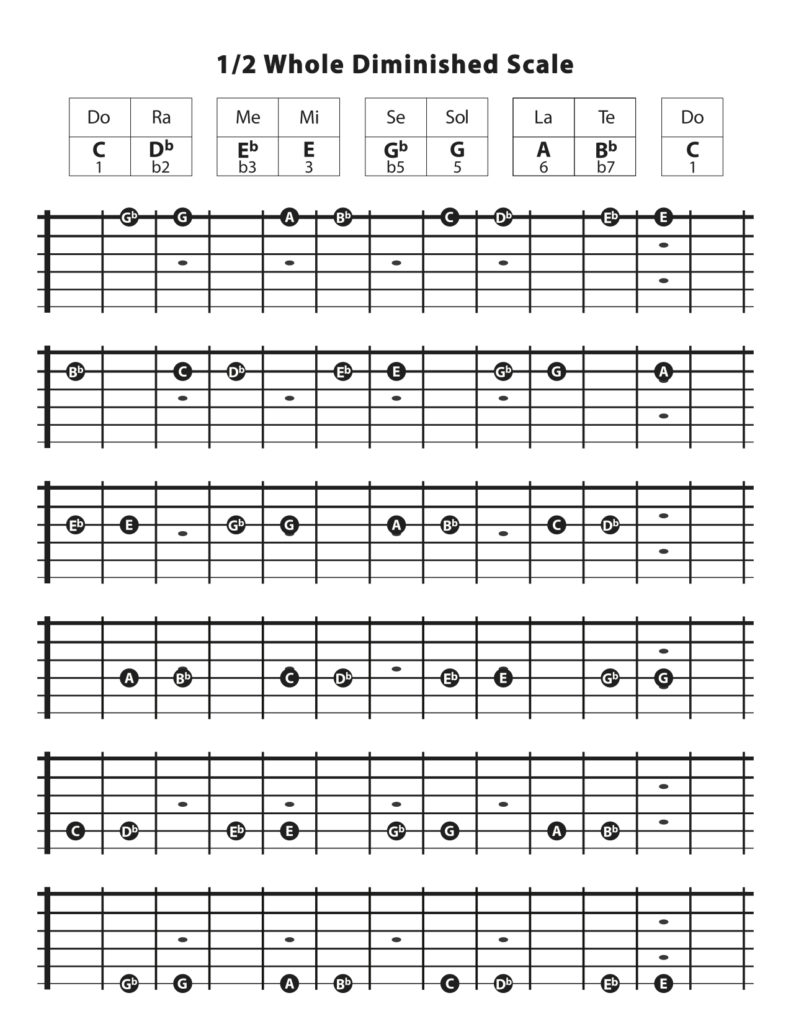The 1/2 Whole Diminished Scale (Single String)
This scale is heavily used in jazz, jazz-rock, and fusion.
Guitar players or bands who come to mind are John Scofield, Mike Stern, Pat Martino, Gypsy jazz guitarists, John McLaughlin, Mahavishnu Orchestra, , and so on.
However: You could really use this scale in any style of music.
The fact it is NOT used as much in for example pop or rock styles can give you the unique edge and sound that sets you apart from other pop and rock players.
The 1/2 Whole Diminished scale belongs to the group of the “octatonic scales”.
The word “octatonic” is derived from the Greek “octo”, which means “eight”. The diminished scale is an 8-note scale.
It’s also a symmetrical scale. Read Here About Symmetrical Scales.
The name “half-whole” diminished, points to the intervallic structure of the scale: it consists of a series of consecutive half and whole steps.
This repetitive interval pattern makes the scale relatively easy to learn.
The formula of the half-whole diminished scale: 1 b2 b3 3 b5 5 6 b7
Translating that to notes, the C 1/2-whole diminished scale is: C Db Eb E Gb G A Bb
Here’s the C 1/2 Whole Dim Scale mapped out on every string.

The 1/2 Whole Diminished Scale Harmony
Knowing the scale is one thing, but knowing how to use it is of course the next step.
This requires knowing what the chords are that you can use this scale over.
You figure this out by looking at the notes in the scale.
- There are 4 major triads:
C E G = C
Eb G Bb = Eb
Gb Bb Db = Gb/F#
A Db/C# E = A - There are 4 dominant 7th chords:
C E G Bb = C7
Eb G Bb Db = Eb7
Gb Bb Db Fb/E = Gb7/F#7
A Db/C# E G = A7 - There are 4 minor triads:
C Eb G = Cm
Eb Gb Bb = Ebm
Gb Bbb/A Db = Gbm
A C E = Am - There are 4 m7 chords:
C Eb G Bb = Cm7
Eb Gb Bb Db = Ebm7
Gb Bbb/A Db Fb/E = Gbm7
A C E G = Am7 - There are 8 dimished triads:
C Eb Gb = Cdim
Db E/Fb G/Abb = Dbdim
Eb Gb Bbb = Ebdim
E G Bb = Edim
Gb Bbb/A Dbb/C or F# A C = F#dim
G Bb Db = Gdim
A C Eb = Adim
Bb Db Fb/E = Bbdim - There are 8 dim7 chords:
C Eb Gb Bbb= Cdim7
Db E/Fb G/Abb Cbb/Bb = Dbdim7/C#dim7
Eb Gb Bbb Dbb = Ebdim7
E G Bb Db = Edim7
Gb Bbb/A Dbb/C Fbb/Eb or F# A C Eb = F#dim7
G Bb Db Fb= Gdim7
A C Eb Gb= Adim7
Bb Db Fb/E Abb/G = Bbdim7 - There are 4 m7b5 chords (also called “half diminished 7th chords”):
C Eb Gb Bb= Cm7b5
Eb Gb Bbb Db = Ebm7b5/D#m7b5
Gb Bbb/A Dbb/C Fb/E or F# A C E = Gbm7b5/F#m7b5
A C Eb G= Am7b5 - Altered Dominant Chords:
C E Gb B = C7b5
Eb G Bbb/A Db = Eb7b5
Gb Bb Dbb/C Fb/E = Gb7b5/F#7b5
A Db/C# Eb G = A7b5The available tensions on these dominant chords in this scale are: b5, b9, #9, 13
How to Use the 1/2-Whole Diminished Scale
- Over Dom7 Grooves.
One of the more common uses of this scale is over dominant chords.
You could use the C 1/2-whole dim scale over the C7 chord. This gives you fun new sounds and colors.This is how it sounds like when you solo over a C7 groove.
- Over the V7 Chord in Chord Progressions.
You can of course also use it in chord progressions.
As an example, over following chord progression in the key of F:Fmaj7 | Gm7 | C7 | Fmaj7
- Over Symmetrical Chord Progressions.
These are unique, really interesting chord progressions derived from a symmetrical scale.
As an example: when you look at the chords in the C 1/2-whole diminished scale, you see there are 4 V7 chords. They are all 3 frets apart.
||: C7 | Eb7 | F#7 | A7 :||
It sounds like this:
- Over dim7 Chords.
Another fun use, is in chord progressions that have diminished chords. Learn more about that here: The Uses of the Dim7 Chord.
You would use the C# 1/2-whole dim scale over the C#dim7 chord in following example:
C | C#dim7 | Dm G7 ||
It sounds like this:
Next week, we’ll cover the in-position fingerings for this scale.
Hit me up anytime at vreny@zotzinmusic.com if you would like me to send you backing tracks for any of the above chord progressions, if you have any questions, or if you would like to book a lesson.
You’re on your way to becoming a great guitar player.
Have fun! 🙂
Conclusion
Hit me up anytime at vreny@zotzinmusic.com if you have any questions, or if you would like to book a lesson.
These free lessons are cool, but you will never experience the progress, joy, and results that my students experience in lessons when you’re learning by yourself from blogs and videos.
That is why people take lessons: way better results and progress, much more complete information, exposed to way more creative ideas than you can get from a blog or YouTube video.
There is only so much that self-study can accomplish.
If you want to see amazing results and progress in your guitar playing, buy your first lesson here and get started ASAP.
You’ll impress your friends and loved ones in no time with your guitar playing!
Consider donating any small amount to help me keep this blog going.
Thank you for your support!


